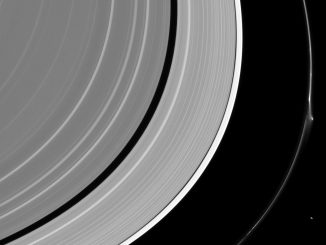
Saturn’s rings


Enceladus: water world
This view of Saturn’s moon Enceladus above the planet’s ring plane was captured by the narrow-angle camera of NASA’s Cassini spacecraft at a distance of approximately 630,000 miles (1 million kilometres) from the tiny water world. Enceladus is subject to forces that heat a global ocean of liquid water under its icy surface, resulting in its famous south polar water jets which are just visible below the moon’s dark, southern limb.

Asteroid ripped apart to form star’s glowing ring system
The remains of a fatal interaction between a dead star and its asteroid supper have been observed in detail for the first time. An international team of astronomers used the Very Large Telescope at ESO’s Paranal Observatory in Chile and other observatories to study the shattered remains of an asteroid around a stellar remnant — a white dwarf.

Entranced by a transit of Dione
Saturn’s 698-mile-wide moon Dione crosses the face of the giant planet in a phenomenon known as a transit. Transits play an important role in astronomy and can be used to study the orbits of planets and their atmospheres, both in our solar system and in others. By carefully observing and timing transits, scientists can more precisely determine the orbital parameters of planetary moons.


